 W
WThe 10th edition of Systema Naturae is a book written by Swedish naturalist Carl Linnaeus and published in two volumes in 1758 and 1759, which marks the starting point of zoological nomenclature. In it, Linnaeus introduced binomial nomenclature for animals, something he had already done for plants in his 1753 publication of Species Plantarum.
 W
WThe Atlas of the British Flora is a book by Franklyn Perring and S. Max Walters, published by the Botanical Society of the British Isles.
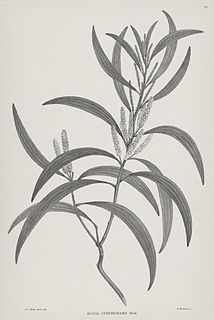 W
WBanks' Florilegium is a collection of copperplate engravings of plants collected by Sir Joseph Banks and Daniel Solander while they accompanied Captain James Cook on his voyage around the world between 1768 and 1771. They collected plants in Madeira, Brazil, Tierra del Fuego, the Society Islands, New Zealand, Australia and Java. During this voyage, Banks and Solander collected nearly 30,000 dried specimens, eventually leading to the description of 110 new genera and 1300 new species, which increased the known flora of the world by 25 per cent.
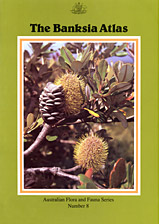 W
WThe Banksia Atlas is an atlas that documents the ranges, habitats and growth forms of various species and other subgeneric taxa of Banksia, an iconic Australian wildflower genus. First published in 1988, it was the result of a three-year nationwide program involving over 400 amateur and professional volunteers.
 W
WThe genus Banksia L.f. (Proteaceae) is a 1981 monograph by Alex George on the taxonomy of the plant genus Banksia. Published by the Western Australian Herbarium as Nuytsia 3(3), it presented George's taxonomic arrangement of Banksia, the first major taxonomic revision of the genus since George Bentham published his arrangement in Flora Australiensis in 1870.
 W
WBartram's Travels is the short title of naturalist William Bartram's book describing his travels in the American South and encounters with American Indians between 1773 and 1777. The book was published in Philadelphia, Pennsylvania in 1791 by the firm of James & Johnson.
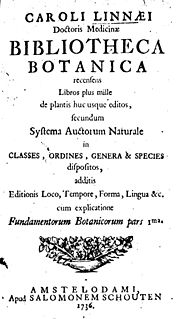 W
WBibliotheca Botanica is a botany book by Swedish naturalist Carl Linnaeus (1707–1778). The book was written and published in Amsterdam when Linnaeus was twenty-eight and dedicated to the botanist Johannes Burman (1707–1779). The first edition appeared in 1735 with the full title Bibliotheca Botanica recensens libros plus mille de plantis huc usque editos secundum systema auctorum naturale in classes, ordines, genera et species; it was an elaborate classification system for his catalogue of books.
 W
WBotany in a Day: The Patterns Method of Plant Identification is a book by Thomas J. Elpel published by HOPS Press, LLC. The book emphasizes family characteristics for plant identification. Related plants typically have similar floral features and often similar uses. For example, plants of the mustard family (Brassicaceae) have four petals with six stamens, and most or all of the 3,200 species are considered edible.
 W
WBraiding Sweetgrass: Indigenous Wisdom, Scientific Knowledge, and the Teachings of Plants is a 2013 nonfiction book by Robin Wall Kimmerer and published by Milkweed.
 W
WBritish Plant Communities is a five-volume work, edited by John S. Rodwell and published by Cambridge University Press, which describes the plant communities which comprise the British National Vegetation Classification.
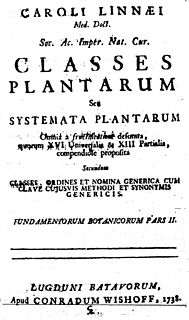 W
WClasses Plantarum is a book that was written by Carl Linnaeus, a Swedish botanist, physician, zoologist and naturalist.
 W
WCritica Botanica was written by Swedish botanist, physician, zoologist and naturalist Carl Linnaeus (1707–1778). The book was published in Germany when Linnaeus was twenty-nine with a discursus by the botanist Johannes Browallius (1707–1755), bishop of Åbo. The first and only edition was published in July 1737 under the full title Critica botanica in qua nomina plantarum generica, specifica & variantia examini subjiciuntur, selectoria confirmantur, indigna rejiciuntur; simulque doctrina circa denominationem plantarum traditur. Seu Fundamentorum botanicorum pars IV Accedit Johannis Browallii De necessitate historiae naturalis discursus.
 W
WDe historia stirpium commentarii insignes is a book by Leonhart Fuchs on herbal plants published in Basel in 1542. The work covers about 497 plants and has over 500 woodcut illustrations. Over 100 of the plants in the book were first descriptions.
 W
WDie Natürlichen Pflanzenfamilien (1887–1915) by Adolf Engler (1844–1930) and Karl Anton Prantl is a complete revision of plant families down to generic level and often even further. As such it forms part of the Engler system of plant taxonomy.
 W
WDouglas Houghton Campbell was an American botanist and university professor. He was one of the 15 founding professors at Stanford University. His death was described as "the end of an era of a group of great plant morphologists."
 W
WJohannes Eugenius Bülow Warming, known as Eugen Warming, was a Danish botanist and a main founding figure of the scientific discipline of ecology. Warming wrote the first textbook (1895) on plant ecology, taught the first university course in ecology and gave the concept its meaning and content. “If one individual can be singled out to be honoured as the founder of ecology, Warming should gain precedence”.
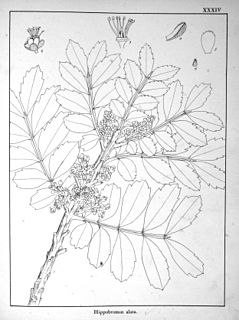 W
WThe Forests and Forest Flora of the Colony of the Cape of Good Hope, is a botanical reference book written and illustrated by Thomas Robertson Sim, and published in 1907 by Taylor & Henderson of Aberdeen. At the time he was the Conservator of Forests of Natal, and had been the District Forest Officer in King William's Town, bringing a wealth of experience to the creation of this monumental work. Sim had previously written a great many books such as "Handbook of Kaffrarian Ferns", "The Ferns of South Africa" and "Botanical Observations on the Forests of Eastern Pondoland". He was a Fellow of both the Linnaean Society and the Royal Horticultural Society, with sterling credentials for producing this extensive flora of the Cape.
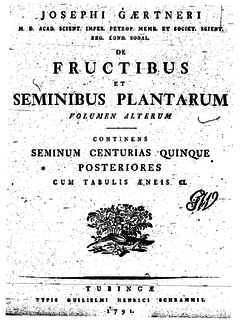 W
WDe Fructibus et Seminibus Plantarum, also known by its standard botanical abbreviation Fruct. Sem. Pl., is a three-volume botanic treatise by Joseph Gaertner. The first volume was published in December 1788. The second volume was published in four parts, in 1790, 1791, 1791 and 1792 respectively. A third volume was published after Gaertner's death by his son Karl Friedrich von Gaertner from 1805 to 1807; this final volume is also known as 'Supplementum Carpologicae', abbreviated as Suppl. Carp.. Most of the illustrations for the work were done by Johann Georg Sturm (1742-1793).
 W
WFundamenta Botanica was one of the major works of the Swedish botanist, zoologist and physician Carl Linnaeus (1707–1778) and issued both as a separate work and part of the Bibliotheca Botanica.
 W
WGenera Plantarum is a publication of Swedish naturalist Carl Linnaeus (1707–1778). The first edition was issued in Leiden, 1737. The fifth edition served as a complementary volume to Species Plantarum (1753). Article 13 of the International Code of Nomenclature for algae, fungi, and plants states that "Generic names that appear in Linnaeus' Species Plantarum ed. 1 (1753) and ed. 2 (1762–63) are associated with the first subsequent description given under those names in Linnaeus' Genera Plantarum ed. 5 (1754) and ed. 6 (1764)." This defines the starting point for nomenclature of most groups of plants.
 W
WThe Gottorfer Codex (German) or det gottorpske kodeks (Danish) is a four volume work commissioned by Frederick III, Duke of Holstein-Gottorp between 1649 and 1659 to depict the wide assortment of plants that grew in the ducal gardens at Gottorf Castle (Gottorp) in the duchy of Schleswig.
 W
WHistoria Plantarum is an extensive botanical encyclopedia by the Swiss natural scientist, Conrad Gessner. Although compiled between 1555 and 1565, it was not published till after 1750, since he died of the plague, prior to its completion. To complete the work, he amassed a collection of some 1,500 drawings of plants, most of which were his own work. The scale and scientific rigour were unusual for the time, and Gessner was a skilled artist, producing detailed drawings of specific plant parts that illustrated their characteristics, with extensive marginal notation discussing their growth form and habitation.
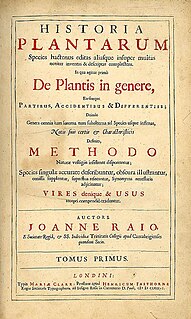 W
WHistoria Plantarum is a botany book by John Ray, published in 1686.
 W
WTheophrastus's Enquiry into Plants or Historia Plantarum was, along with his mentor Aristotle's History of Animals, Pliny the Elder's Natural History and Dioscorides's De materia medica, one of the most important books of natural history written in ancient times, and like them it was influential in the Renaissance. Theophrastus looks at plant structure, reproduction and growth; the varieties of plant around the world; wood; wild and cultivated plants; and their uses. Book 9 in particular, on the medicinal uses of plants, is one of the first herbals, describing juices, gums and resins extracted from plants, and how to gather them.
 W
WThe Hortus Cliffortianus is a work of early botanical literature published in 1737.
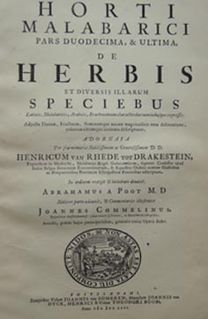 W
WHortus Malabaricus is a comprehensive treatise that deals with the properties of the flora of the Western Ghats region principally covering the areas now in the Indian states of Kerala, Karnataka and Goa, written by Hendrik Van Rheede and Itty Achuthan Vaidyar
 W
WHortus semper virens is a botanical reference book by Johann Simon von Kerner, from 1827.
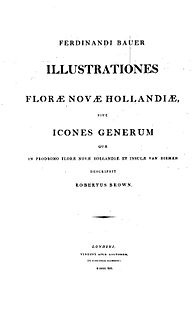 W
WIllustrationes florae Novae Hollandiae is an 1813 publication by the botanical illustrator Ferdinand Bauer.
 W
WIndian Trees: An Account of Trees, Shrubs, Woody Climbers, Bamboos, and Palms Indigenous or Commonly Cultivated in the British Indian Empire is a monograph on the trees of India, written by the German–British botanist and forestry administrator Sir Dietrich Brandis and published in London in 1906 by Archibald Constable & Co.
 W
WInsectivorous Plants is a book by British naturalist and evolutionary theory pioneer Charles Darwin, first published on 2 July 1875 in London.
 W
WThe International Plant Names Index (IPNI) describes itself as "a database of the names and associated basic bibliographical details of seed plants, ferns and lycophytes." Coverage of plant names is best at the rank of species and genus. It includes basic bibliographical details associated with the names. Its goals include eliminating the need for repeated reference to primary sources for basic bibliographic information about plant names.
 W
WThe Johnson Papyrus is a fragment of an early 5th century AD herbal. It is the oldest extant manuscript illustration of a plant. The papyrus fragment shows a sphere of dark blue-green leaves supported by some small scraggly roots. Below the illustration is a fragment of Greek text. The illustrated plant has been identified as "symphyton", which was an important medicinal plant. However the illustration does not closely resemble comfrey, so that, if the identification is correct, the illustration would have had been of little use as an aid to identification.
 W
WLawrence James Metcalf (1928–2017) was an internationally recognized New Zealand horticulturalist, botanist, conservationist and prolific author of gardening and plant identification books.. During a lengthy career, Metcalf popularized and advocated for the planting of native or indigenous plant species in both public and private gardens and pioneered their propagation techniques (horticulture). In 1991 the British Royal Horticultural Society' recognized his work on the cultivation of New Zealand's native plants, by awarding Metcalf the Gold Veitch Memorial Medal.
 W
WDouglas Houghton Campbell was an American botanist and university professor. He was one of the 15 founding professors at Stanford University. His death was described as "the end of an era of a group of great plant morphologists."
 W
WMantissa Plantarum Altera,, is an illustrated book with botanical descriptions which was edited by the Swedish naturalist Carl Linnaeus in the year 1771.
 W
WThe Nanfang caomu zhuang, attributed to the Western Jin dynasty scholar and botanist Ji Han, is a Flora describing the plants of Nanyue and Jiaozhi, present-day South China and northern Vietnam. The Nanfang caomu zhuang is the oldest work extant in any language on subtropical botany. The book contains the first descriptions of several economic plants, for instance jasmine and black pepper, as well as the earliest accounts of some agricultural techniques such as biological pest control, and the cultivation of vegetables on floating gardens.
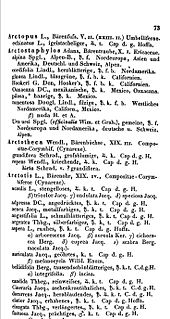 W
WNomenclator Botanicus Hortensis aka Nomencl. Bot. Hort. is an 1840-46 alphabetic index of cultivated plants from the gardens of Europe by the German botanist Gustav Heynhold. It includes synonyms, botanical authors, countries of origin and cultivation. It was published in Dresden and Leipzig by the firm Arnoldischen Buchhandlung with an introduction by Ludwig Reichenbach.
 W
WNova genera plantarum, commonly abbreviated as Nov. Gen. Pl., was a register of plants published from Uppsala by Thunberg from 1781 onwards, listing new genera. Contributing editors werePeter Ulrik Berg Carl Fredrik Blumenberg Nils Gustaf Bodin Pehr Branström Claës Fredrik Hornstedt, 1758–1809 Carl Fredrik Lexow Johan Gustaf Lodin Claus Erik Mellerborg Carl Henrik Salberg Andreas Gustaf Salmenius Carl Fredrik Sjöbeck Gustaf Erik Sörling Gabriel Tobias Ström, 1770–1840 Erik Carl Trafvenfeldt Conrad Wallenius Samuel Wallner, 1778–1865
 W
WO Přirozenosti Rostlin is a Czech botanical text written by Friedrich von Berchtold and Jan Svatopluk Presl, and published in Prague in 1820. A later expanded edition in three volumes was published between 1823 and 1835. The full title of the 1820 work is O přirozenosti Rostlin, obsahugjcj gednánj o žiwobytj rostlin pro sebe a z ohledu giných žiwoků, podlé stawu nyněgss ylo znanj, pýtwu rostlin; názwoslowj audů; hospodářstwj gegich; rozssjřenj po semi a způsob rostlinář zřjditi a zacowati but is generally referred to as O Prirozenosti Rostlin, and the standardised abbreviations is Prir. Rostlin.
 W
WLes observations de plusieurs singularitez et choses memorables trouvées en Grèce, Asie, Judée, Egypte, Arabie et autres pays estranges is a work of ethnographical, botanical and zoological exploration by Pierre Belon (1517–1564), a French naturalist from Le Mans. Starting in 1546, Belon travelled through Greece, Asia Minor, Egypt, Arabia and Palestine, returning to France in 1549.
 W
WOn Plants is a botanical treatise included in the Corpus Aristotelicum but usually regarded as spurious. Most scholars believe the work to have been written by the historian and philosopher Nicolaus of Damascus in the first century BC. On Plants describes the nature and origins of plants.
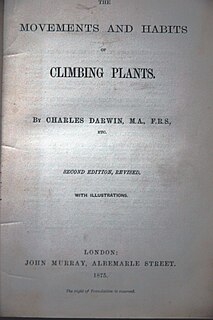 W
WOn the Movements and Habits of Climbing Plants is a book by Charles Darwin first printed in book form in 1875 by John Murray. Originally, the text appeared as essay in the 9th volume of the Journal of the Linnean Society, therefore the first edition in book form is actually called the ‘second edition, revised.’ Illustrations were drawn by Charles Darwin’s son, George Darwin.
 W
WThe Paradisus Londonensis is a book dated 1805–1808, printed by D.N. Shury, and published by William Hooker. It consists of coloured illustrations of 117 plants drawn by William Hooker, with explanatory text by Richard Anthony Salisbury.
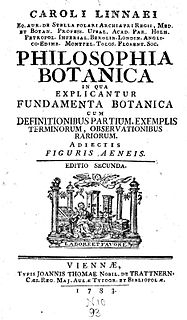 W
WPhilosophia Botanica was published by the Swedish naturalist and physician Carl Linnaeus (1707–1778) who greatly influenced the development of botanical taxonomy and systematics in the 18th and 19th centuries. It is "the first textbook of descriptive systematic botany and botanical Latin". It also contains Linnaeus's first published description of his binomial nomenclature.
 W
WPlantae Asiaticae Rariores is a horticultural work published in 1830–1832 by the Danish botanist Nathaniel Wallich.
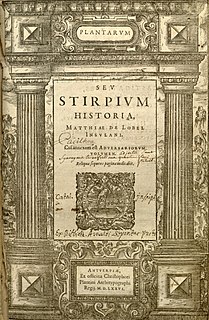 W
W'Plantarum seu stirpium historia' is an illustrated botanical text by the Flemish physician Lobelius (Matthias de l'Obel and published in Antwerp in 1576. Later, he translated it into Flemish in 1581 with the title Kruydtboeck. This was l'Obel's second work, following publication of the Stirpium adversaria nova in London in 1570. This work was intended as a companion publication to his Stirpium adversaria nova, and incorporates a revised version of the latter, as Nova stirpium adversaria.
 W
WThe Power of Movement in Plants is a book by Charles Darwin on phototropism and other types of movement in plants. This book continues his work in producing evidence for his theory of natural selection. As it was one of his last books, followed only by the publication of The Formation of Vegetable Mould through the Action of Worms, he was assisted by his son Francis in conducting the necessary experiments and preparing the manuscript. The Power of Movement in Plants was published 6 November 1880, and 1500 copies were quickly sold by publisher John Murray.
 W
WProdromus Systematis Naturalis Regni Vegetabilis (1824–1873), also known by its standard botanical abbreviation Prodr. (DC.), is a 17-volume treatise on botany initiated by Augustin Pyramus de Candolle. De Candolle intended it as a summary of all known seed plants, encompassing taxonomy, ecology, evolution and biogeography. He authored seven volumes between 1824 and 1839, but died in 1841. His son, Alphonse de Candolle, then took up the work, editing a further ten volumes, with contributions from a range of authors. Volume 17 was published in October 1873. The fourth and final part of the index came out in 1874. The Prodromus remained incomplete, dealing only with dicotyledons.
 W
WRevisio Generum Plantarum, also known by its standard botanical abbreviation Revis. Gen. Pl., is a botanic treatise by Otto Kuntze. It was published in three volumes; the first two of these appeared in 1891, and the third was published in two parts in 1893 and 1898.
 W
WThe Secret Life of Plants (1973) is a book by Peter Tompkins and Christopher Bird. The book documents controversial experiments that claim to reveal unusual phenomena regarding plants such as plant sentience, discovered through experimentation. It goes on to discuss philosophies and progressive farming methods based on these findings. The book was heavily criticized by scientists for promoting pseudoscientific claims.
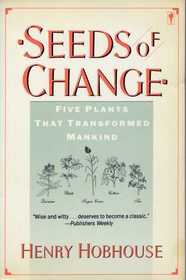 W
WSeeds of Change: Five Plants That Transformed Mankind is a 1985 book by Henry Hobhouse which explains how the history of the world since Columbus linked America to Europe and has been changed by five plants. It describes how mankind's discovery, usage and trade of sugar, tea, cotton, the potato, and quinine have influenced history to make the modern world.
 W
WSpecies Plantarum is a book by Carl Linnaeus, originally published in 1753, which lists every species of plant known at the time, classified into genera. It is the first work to consistently apply binomial names and was the starting point for the naming of plants.
 W
WDouglas Houghton Campbell was an American botanist and university professor. He was one of the 15 founding professors at Stanford University. His death was described as "the end of an era of a group of great plant morphologists."
 W
WStudies of Flowers from Nature is a 19th-century botanical copybook notable for the high quality of its illustrations by an artist known only as "Miss Smith."
 W
WSyllabus der Pflanzenfamilien (1892–) by Adolf Engler (1844–1930) is a complete revision of plant families down to generic level and often even further. As such it forms part of the Engler system of plant taxonomy.
 W
WSystema Naturae is one of the major works of the Swedish botanist, zoologist and physician Carl Linnaeus (1707–1778) and introduced the Linnaean taxonomy. Although the system, now known as binomial nomenclature, was partially developed by the Bauhin brothers, Gaspard and Johann, 200 years earlier, Linnaeus was first to use it consistently throughout his book. The first edition was published in 1735. The full title of the 10th edition (1758), which was the most important one, was Systema naturæ per regna tria naturæ, secundum classes, ordines, genera, species, cum characteribus, differentiis, synonymis, locis or translated: "System of nature through the three kingdoms of nature, according to classes, orders, genera and species, with characters, differences, synonyms, places".
 W
WSystema Vegetabilium is a book published in four editions, following twelve earlier editions known as Systema Naturae. The first edition, published in 1774 and edited by Johan Andreas Murray is counted as edition 13 because it continues from the 12th edition of Systema Naturae. All the names in it are attributed to Carl Linnaeus. The second edition, published in 1784, includes plant species described by J.A. Murray and Carl Peter Thunberg. The third edition, was edited by Christiaan Hendrik Persoon
 W
WVariation and Evolution in Plants is a book written by G. Ledyard Stebbins, published in 1950. It is one of the key publications embodying the modern synthesis of evolution and genetics, as the first comprehensive publication to discuss the relationship between genetics and natural selection in plants. The book has been described by plant systematist Peter H. Raven as "the most important book on plant evolution of the 20th century" and it remains one of the most cited texts on plant evolution.
 W
WNature's Garden: An Aid to Knowledge of our Wild Flowers and their Insect Visitors (1900), republished as Wild Flowers: An Aid to Knowledge of our Wild Flowers and their Insect Visitors (1901), is a book written by nature writer Neltje Blanchan and published by Doubleday, Page & Company. In order to aid the amateur botanist, it used color to classify flowers, noting that this made it easier for novices to identify specimens, and that insects also used color to identify plants. The book also explored the relationship between flowers and the insects that feed on their nectar, using rather anthropomorphic language, and discussed scientific questions of the time, such as Sprengel's theory that orchids produce no nectar. Her description of the flowers also referred to relevant poetry and folklore. Unlike her book Bird Neighbors, the photographs were taken directly from nature.